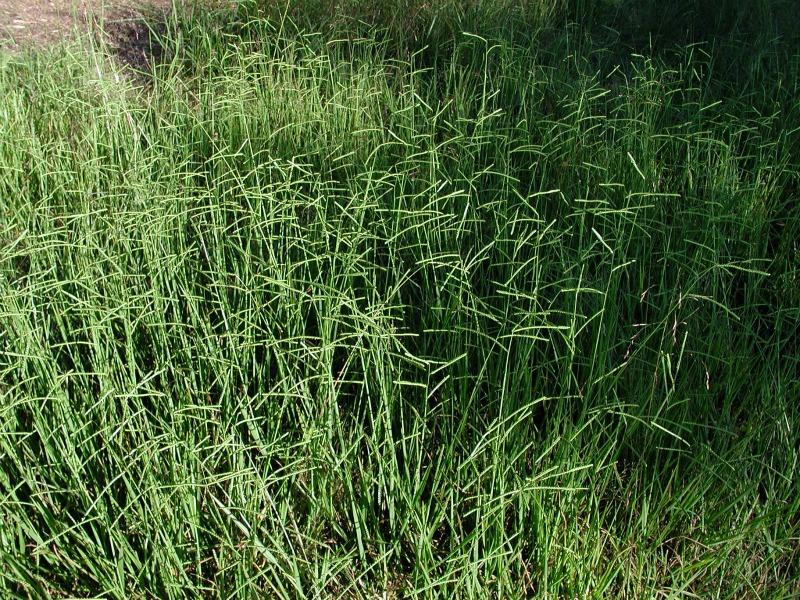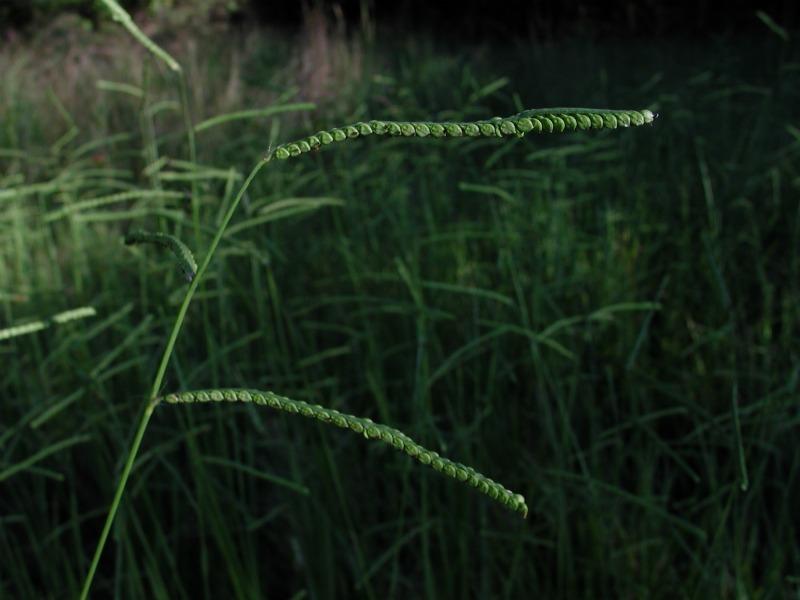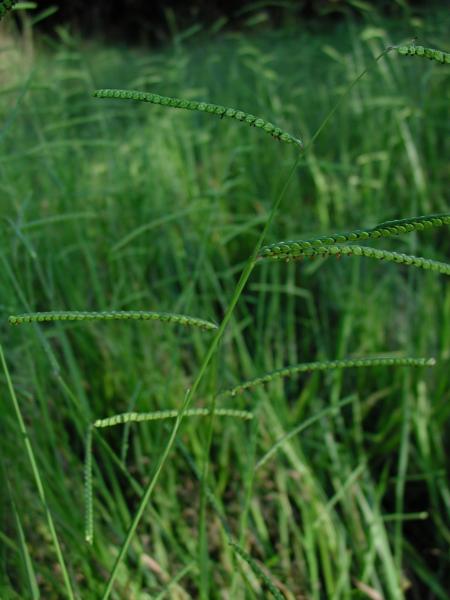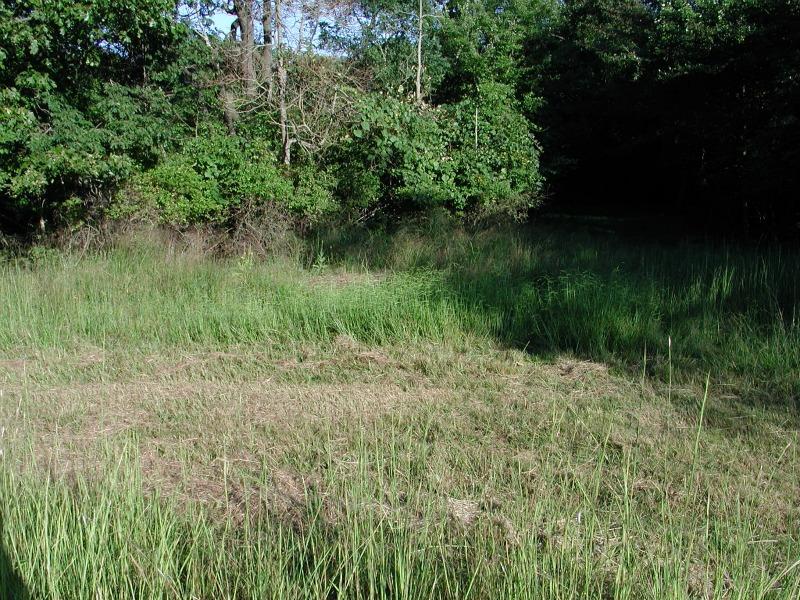Field Bead Grass
Paspalum laeve Michx.
- Class
- Monocotyledoneae (Monocots)
- Family
- Poaceae (Grass Family)
- State Protection
- Rare
A plant listed as Rare by New York State. Removal or damage without the consent of the landowner is prohibited.
- Federal Protection
- Not Listed
- State Conservation Status Rank
- S3
Vulnerable in New York - Vulnerable to disappearing from New York due to rarity or other factors (but not currently imperiled); typically 21 to 80 populations or locations in New York, few individuals, restricted range, few remaining acres (or miles of stream), and/or recent and widespread declines.
- Global Conservation Status Rank
- G4G5
Apparently or Demonstrably Secure globally - Uncommon to common in the world, but not rare; usually widespread, but may be rare in some parts of its range; possibly some cause for long-term concern due to declines or other factors. More information is needed to assign either G4 or G5.
Summary
Did you know?
This grass likes damp sands, often in parks or roadsides, where the plants are often mowed before they can reveal their attractive seed heads.
State Ranking Justification
There are 35 or more existing populations. Population sizes change substantially year-to-year because of their dynamic habitat and mowing regimes.
Short-term Trends
The large populations seem to be fairly stable. Two small populations have not been revisited.
Long-term Trends
The number of populations in New York has always been very small even though there seems to be much habitat. More populations are now being found especially around New York City.
Conservation and Management
Threats
Since plants occur on the borders of roads and fields, the main threats to populations are improper mowing regimes, which may reduce plants if mowed too often or increase competition if not mowed often enough.
Conservation Strategies and Management Practices
This species needs disturbance to reduce competition from woody plants or more aggressive herbaceous plants but too much direct disturbance to the plants will reduce or eliminate the population. Its habitat could be disturbed in the non-growing season to open it up for seed germination and colonization but direct disturbance should be prevented during the growing season.
Habitat
Habitat
Damp meadows, fields, mowed roadsides, mowed grounds, and lawns. Associated species include Trifolium pratense, Plantago major, Plantago lanceolata, Allium vineale, Digitaria, Polygonum aviculare, Setaria and Taraxacum, Daucus carota (New York Natural Heritage Program 2010). Edges of forests and in disturbed areas (FNA 2003). Damp sandy fields, savannas, thickets and shores (Fernald 1970).
Associated Ecological Communities
- Maritime grassland*
(guide)
A grassland community that occurs on rolling outwash plains of the glaciated portion of the Atlantic coastal plain, near the ocean and within the influence of offshore winds and salt spray.
- Mowed lawn
Residential, recreational, or commercial land, or unpaved airport runways in which the groundcover is dominated by clipped grasses and there is less than 30% cover of trees. Ornamental and/or native shrubs may be present, usually with less than 50% cover. The groundcover is maintained by mowing and broadleaf herbicide application.
- Mowed lawn with trees*
Residential, recreational, or commercial land in which the groundcover is dominated by clipped grasses and forbs, and it is shaded by at least 30% cover of trees. Ornamental and/or native shrubs may be present, usually with less than 50% cover. The groundcover is maintained by mowing and broadleaf herbicide application.
- Sedge meadow*
(guide)
A wet meadow community that has organic soils (muck or fibrous peat). Soils are permanently saturated and seasonally flooded. The dominant herbs must be members of the sedge family, typically of the genus Carex.
- Successional old field*
A meadow dominated by forbs and grasses that occurs on sites that have been cleared and plowed (for farming or development), and then abandoned or only occasionally mowed.
- Unpaved road/path
A sparsely vegetated road or pathway of gravel, bare soil, or bedrock outcrop. These roads or pathways are maintained by regular trampling or scraping of the land surface. The substrate consists of the soil or parent material at the site which may be modified by the addition of local organic material (woodchips, logs, etc.) or sand and gravel. Abandoned railroad beds where tracks have been removed are included here. One characteristic plant is path rush.
* probable association but not confirmed.
Associated Species
- Allium vineale (field garlic)
- Andropogon virginicus
- Carex pensylvanica (Pennsylvania sedge)
- Carya glabra (pignut hickory)
- Cirsium arvense (creeping thistle, Canada thistle)
- Danthonia spicata (poverty grass)
- Daucus carota (wild carrot)
- Dichanthelium
- Digitaria
- Festuca
- Helianthemum
- Hypericum gentianoides (orange-grass)
- Hypericum hypericoides
- Hypericum perforatum
- Juncus effusus
- Lechea tenuifolia (narrow-leaved pinweed)
- Lobelia nuttallii (Nuttall's lobelia)
- Lyonia mariana (staggerbush)
- Panicum virgatum (switch grass)
- Pinus rigida (pitch pine)
- Plantago lanceolata (English plantain)
- Plantago major (common plantain)
- Poa compressa (flat-stemmed blue grass, Canada blue grass)
- Polygonum aviculare
- Potentilla simplex (old-field cinquefoil)
- Quercus alba (white oak)
- Quercus velutina (black oak)
- Sassafras albidum (sassafras)
- Schizachyrium scoparium
- Setaria
- Smilax rotundifolia (common greenbrier)
- Solidago nemoralis
- Solidago puberula (downy goldenrod)
- Taraxacum
- Vaccinium pallidum (hillside blueberry)
Range
New York State Distribution
It is known from Suffolk County up through Westchester County.
Global Distribution
It is most common in the South-Central and Eastern US with scattered populations north to the Midwest and Coastal New York and New England.
Identification Comments
General Description
Field Beadgrass is a perennial grass, growing from short rhizomes. The stems are erect and from 40 to 120 centimeters tall, often with several growing together from the base. The leaves have keeled, sometimes hairy sheaths and blades about 5 to 25 cm long and 2 to 10 mm wide. The fruit are borne in from 1 to 6 branches, each arranged as a raceme of singly borne spikelets packed tightly together and close to the stem. The spikelets themselves are elliptical or obovate to round (bead-like), glabrous, about 2.3 to 3.3 millimeters long and nearly as wide, and have 3-veined upper glumes and 5-veined, sterile lemmas (FNA 2003).
Best Life Stage for Proper Identification
Field beadgrass is best identified when in fruit.
Similar Species
The only other species of genus Paspalum in New York is P. setaceum. There are four varieties of P. setaceum known from New York. All of them differ from P. laeve by having paired spikelets and sterile lemmas with two or three veins (P. laeve has solitary spikelets and five-veined sterile lemmas.)
Best Time to See
This grass is best surveyed for from mid-summer into fall.
- Fruiting
The time of year you would expect to find Field Bead Grass fruiting in New York.
Field Bead Grass Images
Taxonomy
Field Bead Grass
Paspalum laeve Michx.
- Kingdom Plantae
- Phylum Anthophyta
- Class Monocotyledoneae
(Monocots)
- Order Cyperales
- Family Poaceae (Grass Family)
- Order Cyperales
- Class Monocotyledoneae
(Monocots)
- Phylum Anthophyta
Additional Common Names
- Field Beadgrass
- Paspalum
Synonyms
- Paspalum circulare Nash
- Paspalum laeve var. circulare (Nash) Stone
- Paspalum laeve var. laeve
- Paspalum laeve var. pilosum Scribn.
- Paspalum plenipilum Nash
Additional Resources
Best Identification Reference
Flora of North America Editorial Committee. 2003. Flora of North America, North of Mexico. Volume 25. Magnoliophyta: Commelinidae (in part): Poaceae, part 2. Oxford University Press, New York. 783 pp.
Other References
Fernald, M.L. 1950. Gray's manual of botany. 8th edition. D. Van Nostrand, New York. 1632 pp.
Gleason, Henry A. and A. Cronquist. 1991. Manual of Vascular Plants of Northeastern United States and Adjacent Canada. The New York Botanical Garden, Bronx, New York. 910 pp.
Holmgren, Noel. 1998. The Illustrated Companion to Gleason and Cronquist's Manual. Illustrations of the Vascular Plants of Northeastern United States and Adjacent Canada. The New York Botanical Garden, Bronx, New York.
Mitchell, Richard S. and Gordon C. Tucker. 1997. Revised Checklist of New York State Plants. Contributions to a Flora of New York State. Checklist IV. Bulletin No. 490. New York State Museum. Albany, NY. 400 pp.
New York Natural Heritage Program. 2010. Biotics database. New York Natural Heritage Program. New York State Department of Environmental Conservation. Albany, NY.
New York Natural Heritage Program. 2024. New York Natural Heritage Program Databases. Albany, NY.
Weldy, T. and D. Werier. 2010. New York flora atlas. [S.M. Landry, K.N. Campbell, and L.D. Mabe (original application development), Florida Center for Community Design and Research http://www.fccdr.usf.edu/. University of South Florida http://www.usf.edu/]. New York Flora Association http://newyork.plantatlas.usf.edu/, Albany, New York
Links
About This Guide
Information for this guide was last updated on: April 11, 2011
Please cite this page as:
New York Natural Heritage Program. 2024.
Online Conservation Guide for
Paspalum laeve.
Available from: https://guides.nynhp.org/field-beadgrass/.
Accessed July 26, 2024.



